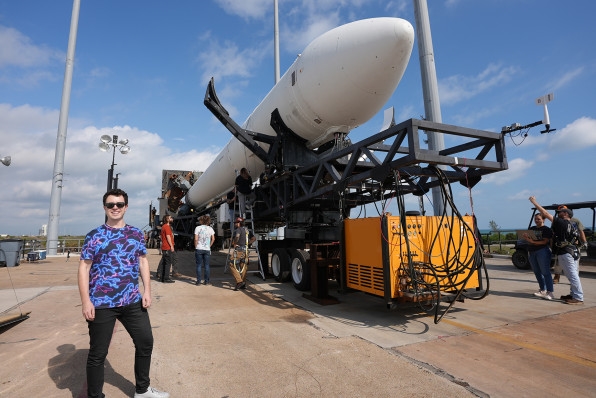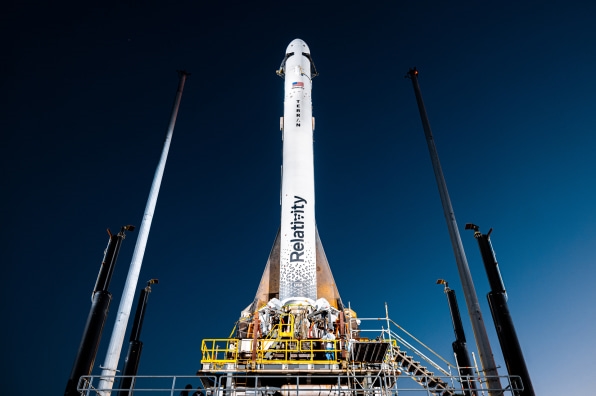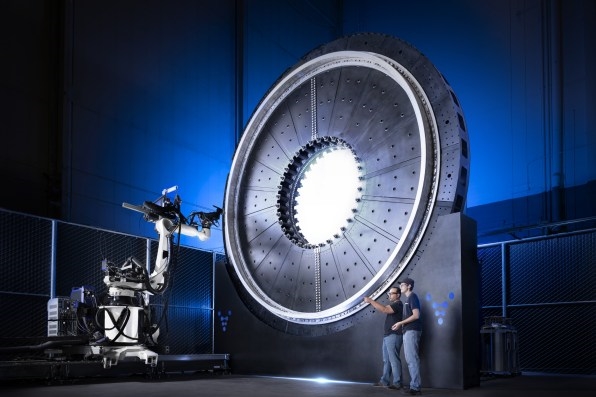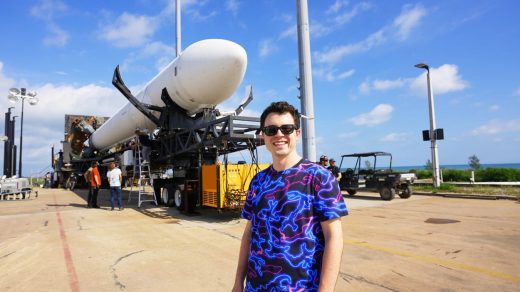How Tim Ellis went from wannabe screenwriter to Elon Musk’s biggest space competitor
Seven years ago, Relativity Space CEO Tim Ellis gave himself a coin-flip’s chance of success with a newfangled way to design and build 3D-printed rockets to expedite humanity’s push to Mars. “It’s technology that, when I started, I honestly thought there was a 50-50 chance that it wasn’t going to work and we’d end up with a puddle of metal,” Ellis tells me when we meet in mid-January. “But there was a real need for somebody to at least try.”
Since then, the privately held company that Ellis started with his college pal Jordan Noone has raised more than $1.3 billion in funding from such backers as Mark Cuban, Black Rock, and Y Combinator, and he oversees 1,000-plus employees across two massive factories in Long Beach, California. Before literally getting off the ground, Ellis’s company, which is valued by investors at $4.2 billion, has presold a whopping $1.8 billion in launches.

Yet even with that substantial foundation comes the moment of truth. Sometime likely in February, Relativity’s first rocket, Terran 1 (“earthling” in sci-fi parlance), is slated to lift off into orbit from Cape Canaveral in Florida. If all goes well, the event will herald a series of firsts: the first 3D-printed rocket to exist, the first liquid oxygen/methane-propelled rocket to launch into orbit, and the first private rocket to be successful on its first attempt. The Terran 1 will also pave the way for a 2024 launch of Relativity’s larger, reusable Terran R rocket, which will compete with SpaceX’s Falcon 9 and ultimately be part of a commercial mission to Mars. Its launch, dubbed “Good Luck, Have Fun”—a phrase uttered at the beginning of competitive online games—will livestream on Relativity’s YouTube channel.
“I’m pumped,” says Ellis of his anticipated reaction. “I’m gonna cry for sure.”
The fusion of art and science
A boyish 32 with infectious enthusiasm, Ellis has always lived in the space between science and imagination, logic and whimsy. A walk through his first factory hints at that—printed rocket parts displayed like sculptures, fairy lights wrapped around shelving, a giant kinetic sculpture descending from the high ceiling in the reception area.

“My wife did that,” says Ellis proudly, pointing to its slowly twirling silver blades. Richelle Ellis is a science-inspired artist whose works also grace the International Space Station, with others earmarked for lunar missions. “She’s a big nerd, too; she’s gonna hate that I said that,” he adds, laughing. “She’s training to be an astronaut. I’m more of a mental daredevil. I’ll tell her which rockets are safe to go on and when she can go. I won’t say on the record which one.”
The pair even came close to opening a science and art-themed gallery. What stuck was its motto: “Art plus science equals wonder,” a concept that informs one another’s work. “Engineering brings imagination to reality that inspires artists to dream bigger and create the next vision,” Ellis says. “Then engineers try to live up to that.”

Initially, creativity was Ellis’s escape from the banality of Texas suburbia. He excelled at science and math, but was more into films than space, heading to the University of Southern California with dreams of a screenwriting career. When writing proved too solitary—“I had this vision of myself being alone in a room, not really talking to anybody, trying to be creative for money”—he swung over to aeronautics engineering. Then that proved too slow and conventional. “I thought, `I’m gonna be alone in a cubicle, just writing code for the rest of my life,” he says. But then he stumbled upon the USC Rocket Propulsion Lab, a student-run club that designed, built, and launched its own rockets that, in 2019, would become the first student group to launch a rocket into space. A single launch trip to the Mojave Desert and he was hooked.
After a string of summer internships working on 3D-printing projects at Blue Origin and completing his master’s at USC at the end of 2013, Ellis joined the company full-time, starting a proof-of-concept metal 3D-printing division and occasionally working with Blue Origin founder Jeff Bezos. “I was really convinced this was the future,” says Ellis, but one that required a redesign of the rocket fabrication process, which was less Blue Origin’s mindset.
Meanwhile, Ellis had been carpooling with Jordan Noone, a friend from Rocket Lab who was working at nearby SpaceX, and the two began formulating ideas for their own space enterprise. “SpaceX had achieved this incredibly inspiring success and not a single other company had been founded yet to go after this long-term mission of making humanity multiplanetary and going to Mars when we need dozens to hundreds if that’s ever going to happen,” says Ellis. “It was the draw and excitement of being the first to try this crazy idea of printing a whole rocket and developing the world’s largest metal 3D printers.”
Their technical vision was that by fusing 3D printing, artificial intelligence, autonomous robotics, and in-house manufacturing, Relativity could craft rockets with one-tenth as many parts of conventionally built ones, thereby lowering potential points of failure and labor costs, streamlining testing with faster corrections, and simplifying its supply chain. Rather than bending and welding parts together, robots layer thin lines of metal alloys into shapes designed via computer, a process that creates rockets in 60 days, compared to the traditional two years.
In early 2016, Ellis and Noone were a respective 25 and 23 and clueless about how even to begin. So Ellis cold-emailed billionaire entrepreneur Mark Cuban after guessing 20 different plausible address variations. Cuban replied immediately with an offer for a half million dollars and later invested in subsequent funding rounds. Startup accelerator Y Combinator followed soon after. Noone served as Relativity’s founding CTO, leaving in 2020 to cofound the investment firm Embedded Ventures, but remains a Relativity executive adviser. Relativity plans to remain private for more flexibility and control.
“The Trump of tech”
Despite drawing inspiration from SpaceX, Ellis is opting for a more supportive managerial style than Elon Musk, who he’s cheekily called “the Trump of technology.” Asked to elaborate, he explains, “I’m a big fan of SpaceX. [Musk is] obviously a genius. He’s achieved an incredible amount. He doesn’t care what people think. He wants to poke and prod society and see where the boundaries are; establish that you can bend the rules. I just think he doesn’t always appreciate how much damage that can cause, too. My approach to leadership is extremely different.”
Early on, Ellis and his team outlined four core values of the company—wonder, audacity, relentlessness, and humanity—a cocktail that embraces emotional intelligence, empathy, and connection as much as IQ. While staffing Relativity with talent from firms such as Blue Origin and SpaceX, he’ll also take chances on fast-learning outsiders who show initiative and flexibility, and says he tries to cultivate leaders within the company and welcome ideas from all employees.
“You’ve got to have big, ambitious goals,” he says. “I’m a calculated risk-taker, but I’m willing to swing for the fences. Relentlessness is how you achieve it. I love the moments where you’re at this precipice of, Is it gonna work or not?, and you have to rally and make it happen. I want to lead through inspiration, not fear. I want people to be pulled and drawn to this amazing vision of what’s possible.”

Ellis’s impetus for going to Mars is similarly optimistic: less about survival, and more about our evolution. “It’s about expanding the experience and emotions of what’s possible to be a human being,” he tells me. He points to the Relativity logo, a single organism slowly splitting into two separate entities, representing separate human existences on Earth and Mars. This is distinct from Musk’s stated reason for going to Mars—as a backup planet as Earth exhausts its resources. “A million people living on another planet with their own society, culture, and news would enrich the complexity of the human experience,” Ellis says. “That would be a really cool future to live in.”

Reel life to real life
The screenwriting has long since taken a back seat to Ellis’s spacefaring dreams, though he and Academy Award-winning actor Jared Leto, a Relativity investor, have briefly discussed some sci-fi movie ideas. Instead, his imagination has found a more profound expression in pushing the boundaries of reality.
That begins with the Terran 1.

For now, Relativity is focused on hauling cargo, not astronauts. It already has deals to send OneWeb broadband satellites to space and set an Impulse Space lander on a course to Mars. But one day, Ellis envisions such technology facilitating a human presence on Mars and repurposed for more sustainable living on Earth.
“If we’re going to exist on Mars, there has to be a factory that’s small and lightweight, that can build products with not a lot of human labor, in very difficult conditions,” Ellis says. “I thought all of that described an intelligent metal, 3D-printing-based factory.”
It’s a vision more audacious than any movie. “I was not a space geek growing up. I cared way more about blowing people’s minds and creating something new,” he says. “Relativity is not a story anymore. We actually have a 3D-printed rocket on the launch pad and we’re about to launch. This is almost real-life sci-fi, which is I think just as cool.”
(60)



